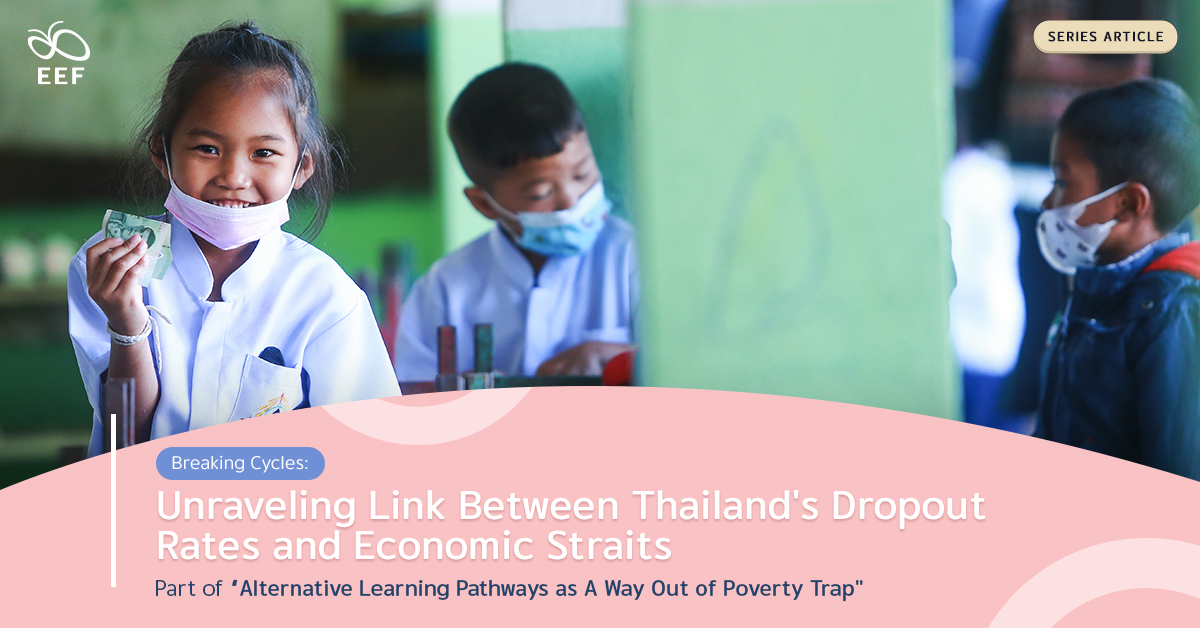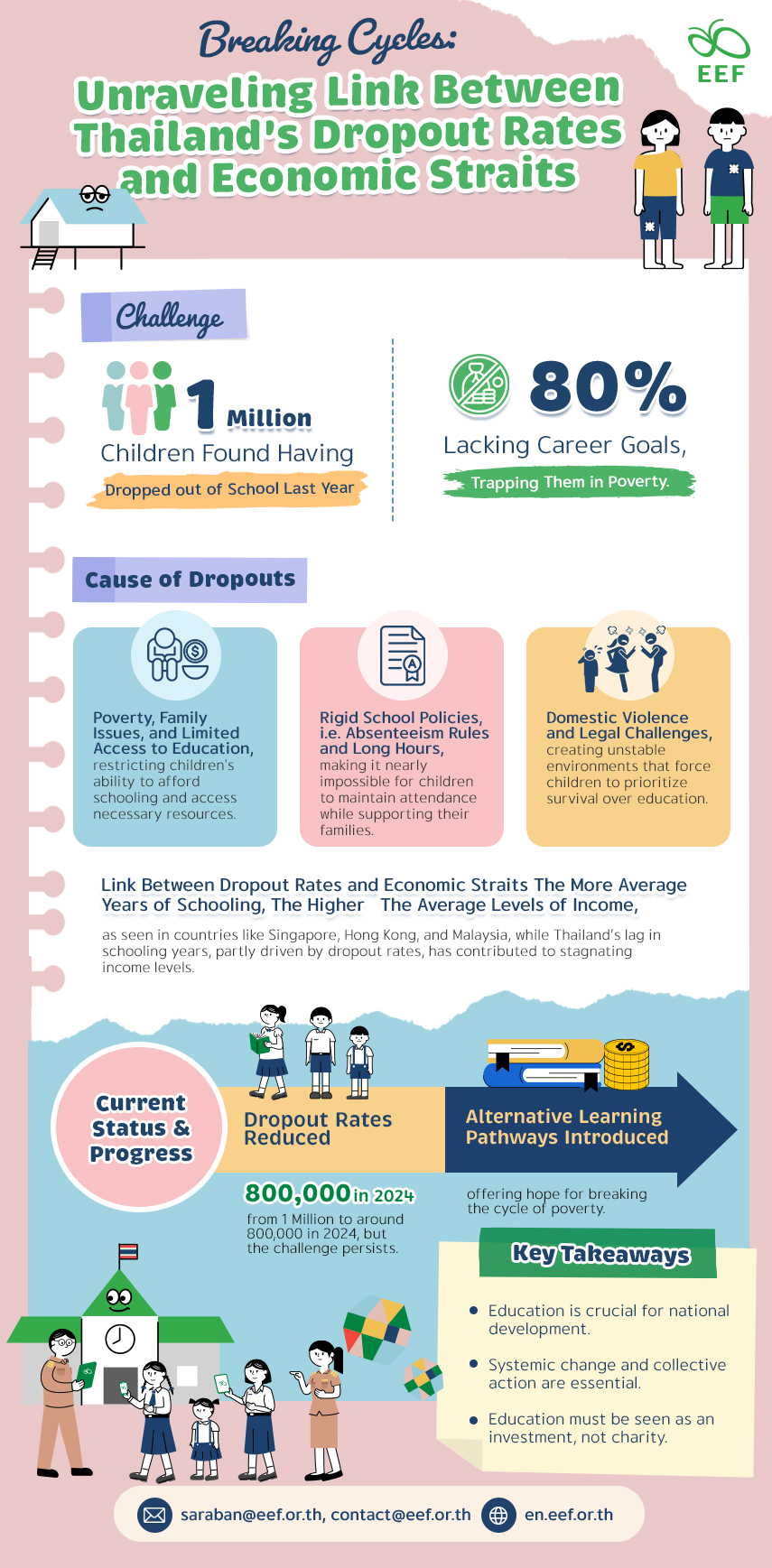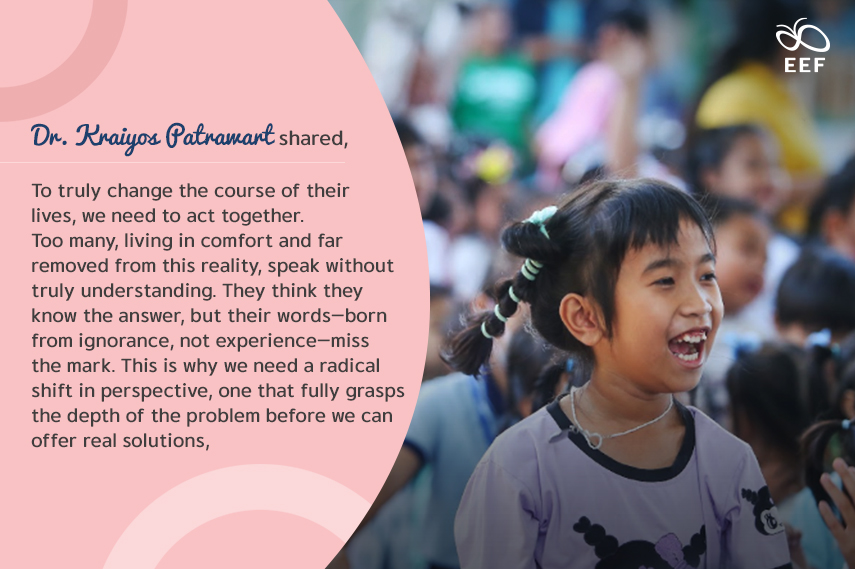
Addressing educational inequality remains a formidable challenge in Thailand, one that has persisted for decades. Despite ongoing discussions, the issue continues to trap children outside the educational system, thus preventing them from breaking free from poverty. This not only affects individual lives but also severely impacts the national economy. The question remains: how can vulnerable children access education, secure sustainable livelihoods, and improve their futures? Are alternative learning pathways a viable solution?

Breaking Cycles: Unraveling Link Between Thailand’s Dropout Rates and Economic Straits
Challenge
1 Million Children Found Having Dropped out of School Last Year,
with 80% Lacking Career Goals, Trapping Them in Poverty.
Cause of Dropouts
- Poverty, Family Issues, and Limited Access to Education, restricting children’s ability to afford schooling and access necessary resources.
- Rigid School Policies, i.e. Absenteeism Rules and Long Hours, making it nearly impossible for children to maintain attendance while supporting their families.
- Domestic Violence and Legal Challenges, creating unstable environments that force children to prioritize survival over education.
Link Between Dropout Rates and Economic Straits
The More Average Years of Schooling, The Higher The Average Levels of Income,
as seen in countries like Singapore, Hong Kong, and Malaysia,
while Thailand’s lag in schooling years, partly driven by dropout rates,
has contributed to stagnating income levels.
Current Status & Progress
- Dropout Rates Reduced, from 1 Million to around 800,000 in 2024, but the challenge persists.
- Alternative Learning Pathways Introduced, offering hope for breaking the cycle of poverty.
Key Takeaways
- Education is crucial for national development.
- Systemic change and collective action are essential.
- Education must be seen as an investment, not charity.
Thailand continues to face a critical challenge with its out-of-school children, as highlighted in the EEF’s report, “Reality and Urgency of the Situation of Out-of-School Children.” Despite efforts from 2019 to 2024 to support the country’s Zero Dropout goal, the post-COVID-19 reality has seen dropout rates surge. In 2023 alone, one million children exited the educational system—driven by poverty, family breakdowns, limited access to basic resources, health issues, legal troubles, and domestic violence. Often, these challenges overlap, compounding the barriers these children face and underscoring the urgency for reform.
Yet amid the crisis, there are signs of hope. Dr. Kraiyos Patrawart shared: “As we’re approaching the end of 2024, there’s a real sense of progress. We’ve reduced the number of out-of-school children from over a million to around 800,000. But the work is far from done; we must prevent these numbers from rising again and continue supporting those who’ve been left behind—helping them return to education and reclaim their future.”
The Managing Director painted a vivid picture of the children still struggling to reintegrate back into the system. He explained the breadth and complexity of their realities: “There are children living with elderly grandparents, balancing school with part-time work. Rigid school hours and strict attendance policies—allowing only 20% absenteeism—make it nearly impossible for them to stay enrolled. In urban areas, there are those who come from migrant labor families who can’t afford education due to their transient lifestyles. And in remote areas, there are those who face long commutes, especially as schools become fewer at higher grade levels.” This snapshot drives home a hard truth: the traditional educational model simply does not accommodate their needs; these children need a system that recognizes their lived experiences—and adapts accordingly.
This dropout crisis is not only an educational emergency but also an economic one. Surveys show that 80% of out-of-school children lack clear career goals or pathways out of poverty, deepening the country’s broader economic struggles. If left unaddressed, the problem will only intensify. The stark correlation between years of schooling and income levels underscores the urgency: Singapore’s 13 years of schooling translates to an income of 240,000 Thai Baht; Hong Kong’s 12 years brings in 140,000 Thai Baht; Taiwan’s 12 years yields 100,000 Thai Baht; Malaysia, once behind Thailand with 9 years, now leads with 11 years, earning 32,000 to 39,000 Thai Baht, with predictions to soon escape the middle-income trap and join the ranks of high-income nations.

Dr. Kraiyos Patrawart reflected on this regional shift: “Looking back over the past 30 years, it’s almost unbelievable that countries like Singapore, Hong Kong, Taiwan, Japan, South Korea, and Malaysia were once behind Thailand in both education and income. These nations—battered by war and economic crises—pulled themselves back up and surged ahead, while Thailand, still stuck here in recovery mode, kept falling further behind. Now, we find ourselves at a crossroads.”
Countries like Singapore and Hong Kong have demonstrated that economic resilience and growth are built on the foundation of accessible, high-quality education. As the Managing Director warns, Thailand risks being overtaken by fast-developing neighbors such as Indonesia and Vietnam unless swift and inclusive educational reform is implemented. Re-engaging out-of-school children, reducing dropout rates, and aligning education with workforce demands are not just policy choices; they’re economic imperatives.
Yet progress is also hindered by societal attitudes. Many still view dropout issues as charity cases or the children themselves as to blame, ignoring the structural forces that push them out of school. Dr. Kraiyos Patrawart challenged this misconception from his experience in the field: “Some might say the stories of these children are full of drama, but let me set the record straight—their lives aren’t about creating drama. From dawn to dusk, their reality is simply that—the harsh, unrelenting truth. They’re not seeking attention or exaggerating their struggles; they are fighting every day just to survive. This is something society needs to grasp.”
Despite the odds, as he pointed out, these children still possess the drive to push forward. However, before they can even think about returning to school, the overwhelming challenges they face—poverty, family breakdowns, and lack of resources—must first be addressed.

“To truly change the course of their lives, we need to act together. Too many, living in comfort and far removed from this reality, speak without truly understanding. They think they know the answer, but their words—born from ignorance, not experience—miss the mark. This is why we need a radical shift in perspective, one that fully grasps the depth of the problem before we can offer real solutions,” said the Managing Director, highlighting how, despite numerous efforts, the issue of children falling through the cracks in education endures.
Educational inequality in Thailand remains a persistent challenge, with poverty, family issues, and lack of resources trapping many children in a cycle of disadvantage; lasting change requires systemic reform, not short-term fixes. The contrast between Thailand’s struggles and the progress of countries like Singapore and Malaysia underscores the urgency. Education must be viewed as an investment in national development, not charity. Only through sustained, collective action can Thailand break this cycle and unlock the full potential of its youth, a mission embodied by the EEF Thailand, which works to reduce educational inequality through research, collaboration, and targeted support for those most in need. The next installment will explore alternative education models, such as flexible vocational programs that equip disadvantaged youth with practical skills and pathways to employment—offering a real chance to escape poverty and fuel the country’s progress.
All For Education is all about people; only when all is in for education is Education For All. Join the movement to reduce educational inequality. Support the EEF by donating to fund research, partnerships, and assistance for children, youth, and adults in need of educational support. Click the link to contribute today and help create a society where education is open and equal for all. Together, we can make a lasting impact.
Click here for the second part of the series.

